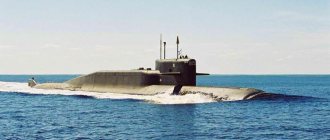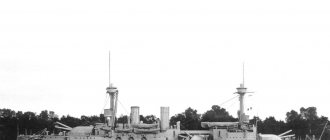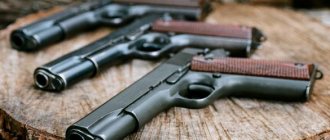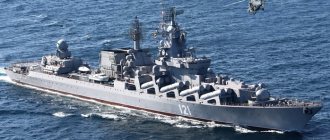"Yaroslav the Wise"
Home / Russia / Composition of the Navy / Surface ships / “Yaroslav the Wise”"Yaroslav the Wise". navsource.narod.ru
"Yaroslav the Mudry" is a patrol ship of the Russian Navy, the second ship of Project 11540 - a series of frigates designed to protect warships and vessels from underwater and surface attacks, search, detect and track submarines, attack ships and vessels, provide landings and solve other problems .
Location
Baltic Fleet.
Building, name
The ship was laid down in Kaliningrad in 1988 under project 11540 and launched in 1990. Construction was frozen due to lack of funding in 1994. In 2002, construction resumed with plans for modernization. The ship was handed over to the Navy on July 24, 2009.
Milestones
In the period from December 7, 2011 to February 14, 2012, the ship made a long voyage to the Mediterranean Sea in order to ensure the naval presence of Russian Navy ships in operationally important areas of the World Ocean.
From July 10 to September 28, 2012, he carried out missions in the North Atlantic, North and Mediterranean seas as part of the joint inter-naval group of the Russian Navy.
On April 25, 2012, he was transferred under the patronage of the head of the Russian Imperial House, Grand Duchess Maria Vladimirovna.
From December 17, 2012 to July 5, 2013 completed long-distance missions in the Atlantic Ocean, North and Mediterranean Seas.
On September 5, 2014, he began performing tasks to ensure the safety of civil navigation in the Red Sea and Gulf of Aden. Then he went to the Indian Ocean, visited Pakistan, Indonesia, Malaysia, and Sri Lanka. On February 21, 2015 he returned to Baltiysk.
On June 16, 2015, the ship was visited by the head of the Russian Imperial House, Grand Duchess Maria Vladimirovna.
In the fall of 2015, she began repairs at the Baltic Shipbuilding Plant. In March 2016, it was tested after repair.
In April 2016, he participated in the professional skills competition “Sea Cup 2016”.
In June 2016, he went to the Mediterranean Sea to replenish the permanent operational force of Russian ships.
In April 2022, he went on a long sea voyage to the Mediterranean Sea and the Indian Ocean.
On October 28, 2022, he returned to Baltiysk from a long sea voyage.
At the end of October 2022, the ship performing long-distance missions arrived in Tartus.
Performance characteristics
Power plant: two-shaft gas turbine type COGAG2 - 2 main gas turbines with a total power of 20,000 hp. and 2 afterburning gas turbines with a total power of 37,000 hp. Power: 57,000 hp (total) Speed: 30 knots; economical: 18 knots Navigation autonomy: 30 days Crew: currently 27 officers, 31 midshipmen and 155 sailors and petty officers
Dimensions
Tonnage: 4500 tons Length: 129.8 meters Beam: 15.6 meters Draft: 8.35 meters
Armament
6,533 mm torpedo tubes 2 anti-submarine missile-torpedo systems "Vodopad-NK" Anti-submarine rocket launcher RBU-6000 4 anti-aircraft missile systems "Kinzhal" 2 anti-aircraft missile and artillery systems "Kortik" 100 mm artillery mount AK-100 with MR control radar -145 "Lion" Anti-submarine helicopter Ka-27
Notes
- ↑ Data on the total power of the SKR project 11540 power plant varies from source to source - for example, Berezhny’s reference book describes it as 2 main engines of 20,000 hp each. With. and 2 afterburners/main engines of 37,000 hp each. With. (total 2*20000+2*37000=114000 horsepower, which is a lot for a small patrol boat). A more realistic value is 58,000 l. With. taken from “Our Aircraft Carriers” by V. Babich. According to this work (section “Gas turbine throw into the oceans”), the total power of each of the two M27 gas turbine units is 19,500 hp from the DO90 main engine. With. and the main gas turbine engine DS71 with 9500 hp. s., which gives 29,000 l. With. for one unit and 58,000 l. With. for the power plant as a whole.
- The Uran complex, originally envisaged by technical design 11540, was not actually installed on the Neustrashimy - at least until the overhaul began in 2014.
- In the Soviet Navy, the crews of warships were formed during the construction phase, therefore, for the first commander, the date of taking office does not coincide with the formal year of the start of the ship's service.
The war in Syria has made Russia despair; it needs to buy 8 ships of Project 054A to come to its senses
The missile attacks in Syria on April 14 no longer attract widespread public attention, but as more details are revealed in connection with this event, many things go beyond speculation. An article in the Russian newspaper Vzglyad dated April 19, in the context of the naval confrontation in Syria, reviewed the Russian and US navies. The author came to the conclusion that “the balance of forces does not seem completely hopeless.” However, Russia is in a very difficult situation, and the only way to salvation for it is to purchase 8 Project 054A frigates from China, that is, an inherently unthinkable contract.
General information
Frigates (according to the original classification - patrol ships of the 2nd rank) in the Russian fleet are designed to search for submarines as part of heterogeneous search and strike groups, ensuring the combat stability of detachments and groups of ships and vessels, including convoys. In addition, Navy frigates, along with ships of the Federal Border Service, can be used to protect biological resources and production activities within the economic zone and the Russian continental shelf. Due to well-known circumstances, Russia after 1991 has been experiencing an ongoing crisis in all spheres, including military-economic. In this regard, with the massive withdrawal of ships from the fleet due to technical condition, the construction of new combat units was almost completely stopped. This has led to the fact that the existing number of frigates does not provide solutions to even the most pressing problems. In terms of their operational and technical qualities, domestic frigates at the time the lead ships of the series entered service were not inferior to the best world models. However, at present, the construction time for ships is being delayed so much that there are fears that they will become obsolete during the construction period.
This is exactly the fate that awaited the Project 11540 patrol ships being built at the Baltic Shipyard. By 1991, only the lead Neustrashimy had been put into operation, and the other two ships, already brought to a high degree of readiness, were mothballed for a long time. More than two decades later, the second frigate, Yaroslav the Wise, was commissioned. The third, “Fog,” was eventually declared obsolete while still on the slipway and scheduled for cutting up for scrap.
With appropriate funding, the Russian shipbuilding industry that has survived to date makes it possible to fully provide the Russian fleet with new frigates and build them for export. This is confirmed by the frigates of the Talvar and Admiral of the Fleet of the Soviet Union Gorshkov types being built for the Indian Navy and the Russian Navy, the creation of which was based on the experience of designing and serving patrol ships of Project 11540.
Reanimators from Novik
In December 1991, along with the disappearance of the USSR, the production of shipboard gas turbine units (GTU) also disappeared on the territory of the Russian Federation. The Mashproekt design bureau and the Zorya production association, which were engaged in the design and production of such gas turbine units in Soviet times, remained in Ukraine. On November 2, 2001, Zorya and Mashproekt merged into the State Enterprise NPKG Zorya-Mashproekt, headquartered in Nikolaev.
Meanwhile, a significant part of the warships of the Russian Navy were equipped with gas turbine units. The dependence on Ukrainian contractors for the production and repair of gas turbine units that arose in 1991 became critical for the Russian fleet by the end of the 2000s. The question of the need to create your own enterprise of the appropriate profile has been repeatedly raised and discussed at various levels in the Russian Federation. And just as often, these initiatives did not lead to any constructive solution to the problem of production/repair of ship gas turbines.
TFR "Yaroslav the Wise"
Problems with the gas turbine unit seriously attracted the attention of the Ministry of Defense only in October 2013. The reason was the failure of the afterburner gas turbine unit on one of the newest ships of the Baltic Fleet at that time, the patrol ship Neustrashimy, after an almost seven-month combat campaign.
The emergency gas turbine unit was dismantled from the ship and prepared to be sent for repairs to the Ukrainian Nikolaev
True, with an important caveat. This time Zorya-Mashproekt was obliged by the contract not only to repair the Neustrashimy gas turbine unit, but also to train specialists from the Russian Federation in similar operations
On the Russian side, the Novik industrial group was among the enterprises that participated in the work to restore the technical readiness of the watchdog. It was the Novik specialists who had to undergo training and internship at the Ukrainian enterprise Zorya-Mashproekt.
The Novik industrial group appeared in 2008. Almost immediately, Novik became a diversified enterprise capable of offering a large range of services, including maintenance, repair and restoration of the technical readiness of not only steam turbine power plants, but also main and auxiliary boiler plants. Along with this, Novik began servicing mine-torpedo weapon systems at the bases of Navy ships and submarines.
With such a wide range of work, Novik needed competencies in the field of applied science. Creating your own design and engineering bureau is not an easy task. During the Soviet era, such teams were formed over decades at specialized enterprises. But chance came to Novik’s aid. The management, as part of the restructuring and optimization campaign of the former state-owned enterprise, decided to get rid of its own turbine design bureau. As a result, the staff of the Kirov design bureau, which was left without work, almost in its entirety, moved to Novik in the summer of 2011, where it formed the design bureau of the same name (PKB).
As subsequent events showed, the creation of this personnel reserve turned out to be critically important. Plans agreed with Ukrainian counterparties to repair the emergency gas turbine unit of the TFR in Nikolaev and train Novik specialists there were prevented by the coup in Kyiv and subsequent events in Crimea and Donbass. Military-technical cooperation between the Russian Federation and Ukraine has ceased. In emergency circumstances, the Russian side had to organize the repair of ship gas turbine units exclusively on its own. Contrary to the pessimism that existed in certain circles regarding such work, a positive result was achieved.
PKB "Novik" together with the Samara OJSC "Kuznetsov" at a plant that dealt not with ship turbines, but with aircraft turbines, began repairing the Neustrashimy gas turbine unit delivered to Samara. Neither Novik nor Kuznetsov had technical documentation for this - it had to be created directly during the repair and commissioning work. It was not possible to resuscitate the Neustrashimy turbine on time. In February 2015, the same afterburner turbine failed on another Project 11540 TFR, Yaroslav the Mudry. The Navy command quickly decided to prioritize the repair of the gas turbine unit of this particular ship. In Samara, they suspended work on the afterburner turbine of the Neustrashimy, waited for the delivery of the Yaroslav the Wise gas turbine, and started working on it. All work on the Mudrogo gas turbine unit was completed within the deadlines specified by the customer.
Description of design
General view of SKR project 11540
Project 11540 patrol ships are single-tube, two-masted ships with a developed superstructure, occupying more than half the length of the upper deck. The architectural and layout solutions implemented in the ships ensure a reduction in the levels of thermal, acoustic, electromagnetic and secondary radar fields.
Frame
"Fearless" in 2006. The characteristic shape of the superstructures and the cover of the towed sonar device in the stern is clearly visible
The ship's hull is a forecastle, with an elongated forecastle and a characteristic bend in the upper deck in the bow to improve conditions for firing from a universal 100-mm gun mount. The underwater part of the hull is equipped with a bulb in which the antenna of the hydroacoustic complex is located. The ship's hull is divided into 12 compartments by watertight bulkheads. Both the hull and superstructure are all steel, constructed using low visibility technologies; All connections are made by welding.
To reduce the level of the reflected radio signal, the designers used an unusual solution: the outer edges of the superstructure, as well as the cover of the towed body in the stern, received corrugated-like fractures along the outer surface. A more traditional solution, used in the military shipbuilding of the USSR since the 1960s and now widespread everywhere, provides for the deviation of the external surfaces of the superstructures from the vertical while maintaining their flat shape. Technologically, the traditional solution is simpler, but it somewhat reduces the useful volume of the upper tiers of superstructures. Probably, the desire to place a maximum of equipment and weapons in a minimum volume pushed the designers of Project 11540 to an unusual way of ensuring stealth.
Power plant and driving performance
Specialists from the 1st Central Research Institute of the Ministry of Defense persistently recommended a combined diesel-gas turbine power plant for the Yastreb as more economical. However, the real capabilities of the domestic industry, which did not produce diesel gear units of suitable power, did not allow in this case to meet the planned delivery date of the lead ship. Therefore, the new project retained the gas turbine with propulsion and main gas turbine engines, tested and improved on the SKR projects 1135M and 11351.
The power plant is two-shaft. For one shaft line, the power unit consists of one main M-70 and one afterburner (main) M-90 gas turbine engines. In total, therefore, the power plant consists of four (two propulsion and two main) gas turbine engines with a total power of 58,000 hp. pp., working through gearboxes with two fixed-pitch propellers. The power plant allows the ship to develop a maximum speed of 30 knots. If necessary, any of the units is capable of rotating both shafts, which makes the power plant more durable and gives greater flexibility when choosing an economic mode of operation.
The cruising range at 18 knots is 3,000 miles, and at 16 knots the ship can cover 3,500 miles without refueling.
Electricity for the ship is provided by a pair of 1250 kW gas turbine generators, one 600 kW gas turbine generator, and two backup diesel generators of 600 kW each.
Crew and habitability
The ships of the project are equipped with pitch stabilizers, as well as bilge keels, which help improve seaworthiness, improve conditions for using weapons and increase comfort for the crew.
The desire to maximally saturate a not very large ship with weapons and equipment led to the compaction of living quarters and household appliances. As a result, some deterioration was noted in the deployment of personnel on the Project 11540 TFR compared to similar ships.
The autonomy of Project 11540 ships in terms of provisions is calculated for 30 days.
Specifications
American ships of the Oliver Perry type can be considered an analogue of Project 11540 frigates, although they began to be built earlier.
| Project 11540 "Hawk" | FFG-7 Oliver H. Perry | |
| Length, m | 129 | 135 |
| Displacement, t | 4350 | 4200 |
| Travel speed, knots | 30 | 29 |
| Armament | 100 mm AU, SAM "Dagger", SAM "Kortik", anti-ship missile system "Uran", RBU-6000, RPK "Vodopad" | 76 mm AU, 20 mm AU, Standard air defense missile system, Harpoon anti-ship missile system, 2 torpedo tubes |
| Cruising range, miles | 3500 | 5000 |
| Crew | 214 | 219 |
The American frigates were intended to provide air defense and anti-aircraft defense on long voyages, for which they were equipped with long-range Standard anti-aircraft missiles and carried two anti-submarine helicopters (instead of one on the Hawks). This also explains the increased cruising range compared to Soviet and Russian ships.
Currently, American frigates are considered obsolete. Almost all ships have been decommissioned or sold.
For more than 20 years, Neustrashimy would be the only Yastreb in service.
And by the time Yaroslav the Wise was completed, it turned out that 11540 had already become obsolete.
Now the future of the Russian fleet is associated with new frigates - Project 22350. The Hawks retained the role of ships that helped survive the “transition period”.
Notes
- ↑ Data on the total power of the SKR project 1155 power plant varies from source to source - for example, Berezhny’s reference book describes it as 2 main engines of 20,000 hp each. With. and 2 afterburners/main engines of 37,000 hp each. With. (total 2*20000+2*37000=114000 horsepower, which is unusually high for a small patrol boat). A more realistic value is 58,000 l. With. taken from “Our Aircraft Carriers” by V. Babich. According to this work (section “Gas turbine throw into the oceans”), the total power of each of the two M27 gas turbine units is 19,500 hp from the DO90 main engine. With. and the main gas turbine engine DS71 with 9500 hp. s., which gives 29,000 l. With. for one unit and 58,000 l. With. for the power plant as a whole.
- The Russian military listed the violations by the US Navy ship that led to the dangerous situation:
- American sailors ignored Rule 13, “Overtaking,” of the International Collision Prevention Regulations. It requires each overtaking vessel to keep clear of the course of the vessel being overtaken;
the Americans flagrantly violated rule 15 “Crossing Situation” of the same rules: no subsequent change in the relative position of the two vessels relieves the overtaking vessel from the obligation to keep clear of the overtaken one until the latter is finally passed and left behind;
- the crew of the American destroyer violated paragraph 1 of article 3 of the 1972 Soviet-American agreement “On the prevention of incidents on the high seas and in the airspace above it” - that ships must remain at a sufficient distance to avoid the risk of collision.
Representatives of the US Navy justified themselves by saying that “the crew of the Russian ship behaved unprofessionally.” The patrolman raised the “ball-diamond-ball” signal, meaning “restricted maneuvering,” while simultaneously demanding the destroyer maintain a safe distance via VHF radio. However, when Gravely
changed course and speed, the patrol ship also changed course - according to the Americans, this indicates that the ship was actually not limited in its ability to maneuver. “Yaroslav the Wise” approached the American destroyer at a distance of about 300 meters and was 5 nautical miles from the aircraft carrier.
Ship commanders
- Captain 3rd Rank Kolyakov Igor Arkadyevich (June 29, 1990—February 23, 1991)
- Captain 2nd Rank Avraamov Nikolai Georgievich (February 23, 1991—May 13, 1993)
- Captain 2nd Rank Ryzhkov Igor Georgievich (May 13, 1993—July 4, 1996)
- Captain 3rd rank Demidovich Igor Dmitrievich (July 4, 1996-1998)
- captain 3rd rank Yasnitsky Pavel Gennadievich (1998—2002)
- captain 2nd rank Kutyshenko Pavel Anatolyevich (2002-2004)
- captain 2nd rank Smirnov Igor Nikolaevich (2004—2007)
- captain 2nd rank Apanovich Alexey Vasilievich (2007—2010)
- captain 2nd rank Baranov Denis Valerievich (2010—2012)
- captain 2nd rank Ashurov Roman Yurievich (2012-2013)
- Captain-Lieutenant Suslov Alexey Grigorievich (2013—2013)
- captain 2nd rank Lipsky Sergey Aleksandrovich (2013-2017)
- captain 3rd rank Vladimir Aleksandrovich Naumov (since 2017)









